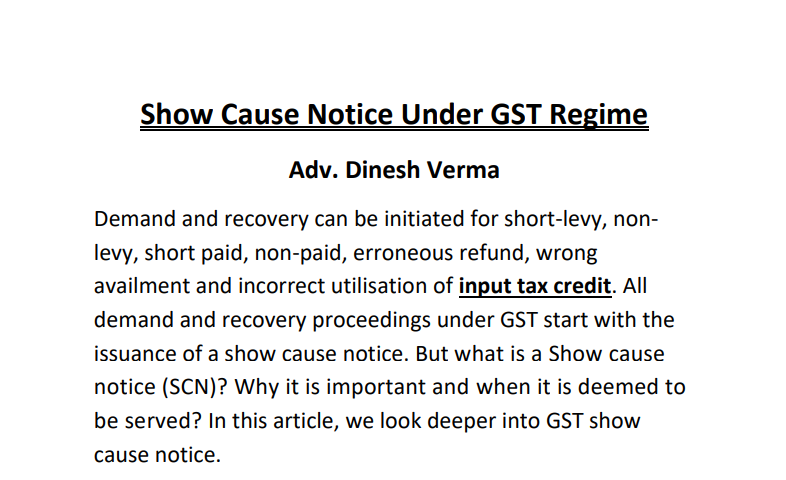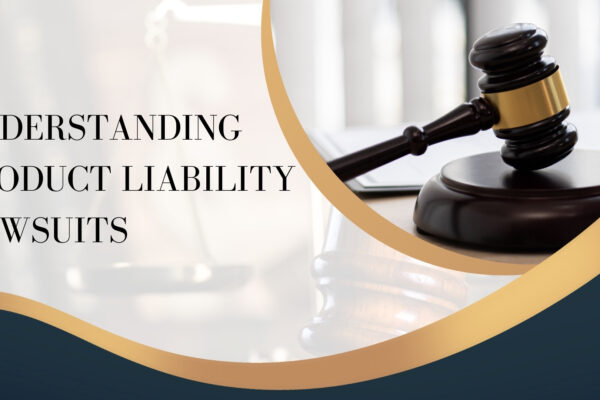Show Cause Notice Under GST Regime
Table of Contents
Show Cause Notice Under GST Regime
Demand and recovery can be initiated for short-levy, non-levy, short paid, non-paid, erroneous refund, wrong availment, and incorrect utilization of input tax credit. All demand and recovery proceedings under GST start with the issuance of a show-cause notice. But what is a show-cause notice (SCN)? Why it is important and when it is deemed to be served? In this article, we look deeper into the GST show-cause notice.
What is Show Cause Notice?
Show cause notice is a formal communication to a person, asking to explain his side for the issue mentioned in the notice. It is generally issued in case of a breach or misconduct at the part of the recipient. Show cause notice implies an order issued by a Court, Competent Authorities or an Organization asking an individual or a group of individuals to explain or to “show cause” in writing concerning why the disciplinary action ought not to be made against the individual or the group of individuals engaged in specific incidents, offense, poor execution, and any wrongdoing.
Supreme court in case of Commissioner of Central Excise, Bangalore Vs Brindavan Beverages private ltd. observed that:
“The show-cause notice is the foundation on which the department has to build up its case. If the allegations in the show cause notice are not specific and are on the contrary vague, lack details and/or unintelligible that is sufficient to hold that the noticee was not given proper opportunity to meet the allegations indicated in the show cause notice. “
Show Cause under GST:
Section 73 of CGST Act deals with issuance of show cause notice to assess for:-
1. Tax is unpaid/short paid or,
2. The refund is wrongly made or,
3. The input tax credit has been wrongly availed/utilized
For any reason, other than fraud, etc. i.e., there is no motive to evade tax.
The proper officer (i.e., GST authorities) will serve a show-cause notice on the taxpayer. They will be required to pay the amount due, along with interest and penalty.
Related Topic:
Ppt on Accounting & Closing of Books under GST regime
Time Limit
The proper officer is obliged to issue the show-cause notice 3 months before the time limit. The maximum time limit for the order of payment is 3 years from the due date for filing of annual return for the year to which the amount relates.
Related Topic:
Reversal of service tax credit on receipt of completion certificate by a developer in GST Regime – A Controversy
Why Show Cause Notice is Important?
In UOI vs Madhumilan Syntex Ltd. 1988 (35) ELT 349, the Supreme court held that any demand raised without issuing show cause notice or granting a hearing would be invalid in terms of section 11A of the Central Excise Act, 1944. In CCE v Kosan metal Products Ltd. 1988 (38) ELT 573, the Supreme court held that show cause notice is necessary before adjudication mere notings in the periodical returns is not a notice. In the case of CCE v Ballarpur Industries 2007 (215) 489 (SC), the Supreme court held that the show cause notice is the foundation in the matter of levy and recovery of duty, penalty and interest; where a certain matter has not been invoked in the show cause notice, it would not be opened to the Central Excise Officer to invoke the same subsequently. Further, the Supreme Court in the case of CC v Toyo Engineering India Ltd. 2006 (201) ELT 513 (SC) held that where a certain grounds were not mentioned in the show-cause notice, the department could not travel beyond the show cause notice.
Why is a show-cause notice (SCN) issued?
It is issued to give the right to the recipient to express his side of the matter. It derives its power from the principle of natural justice. Every person has the right to be heard before any action is taken against him/her.
When itis deemed to be served?
Now there are two parts:-
Issuance of a show-cause notice and its service. It should be properly served. There are many case laws clarifying this issue. In some cases, self-declaration by the taxpayer is enough. Section 169 of the CGST Act also provides the mechanism to deliver it.
Related Topic:
Show cause notice (SCN) in GST
Section 169 of the CGST Act covers the mode of delivery.
• Hand-delivered to the taxpayer
• By speed post or registered post
• Via sending an email
• By making available on the common portal
• Publishing in a newspaper circulated in the vicinity of the taxpayer.
• By affixing it on his place of business
When SCN is not required?
No SCN is required to give him the opportunity of being heard. In the case of Kabeer Reality Private Limited V The Union of India & Others this was observed by MP High court. While filing GSTR1 taxpayer is making a self-declaration of his liability. But he didn’t file GSTR 3b. It had twin effects, Buyers claim ITC based on data auto-populated in 2A as filed in GSTR But no tax was deposited to the government. In this case, a bank account was attached. A notice was sent to the tenants under sections 79(1)(c). The rest was recovered against dues of tax.
Conclusion
Show cause notice means a Court order that requires a party to appear before the court and explain why a certain course of action should not be taken against it. If the party cannot convince the court or fails to appear, that course of action is taken. The Supreme Court and high courts in a large no of cases have deprecated the practice of entertaining the writ petitions questioning the legality of the show cause notices stalling inquiries as proposed and retarding investigation process to find actual facts with the participation. Unless the High court is satisfied that the show cause notice was totally honest in the eye of the law for absolute want of jurisdiction of the authority to even investigate into the fact, writ petitioners will not be entertained for the mere asking and as a matter of routine. The writ petitioners in such cases are directed to respond to the show-cause notice and take all stands highlighted in the writ petition before the Adjudicating Authority.
Read the copy:

 Advocate Dinesh Verma
Advocate Dinesh Verma











